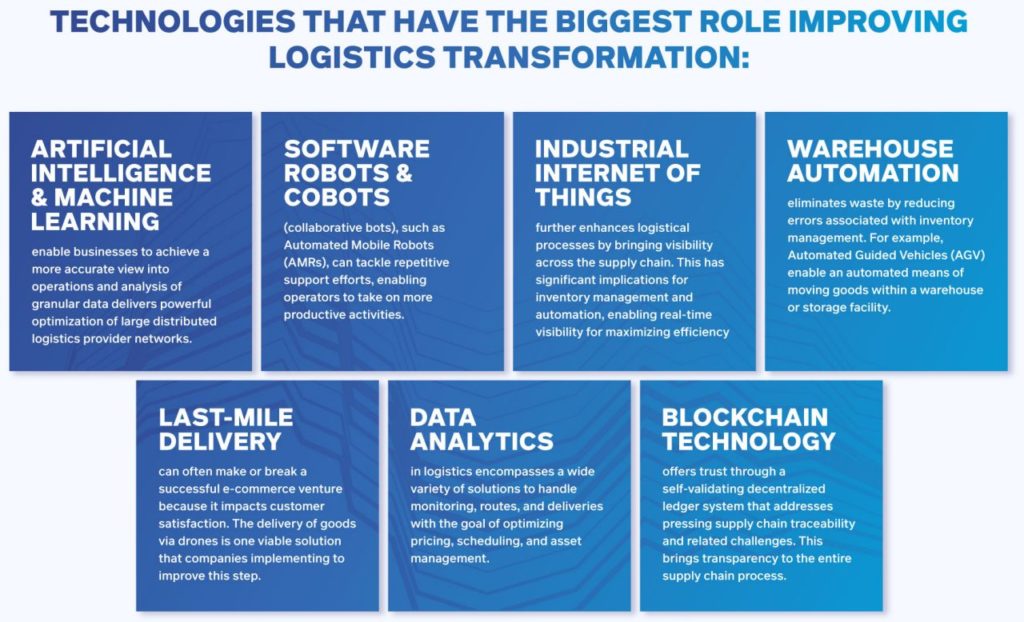A flawless supply chain and logistics management system is what makes or breaks a manufacturing business. You need an efficient logistics system to deliver on business goals and drive profitable outcomes. The timeframe between the purchase and delivery of goods and services is what will set a company apart from everyone else.
Over the last decades, logistics and manufacturing have undergone a massive change. However, the goal remains the same: fulfill customer demand, drive value, and improve responsiveness in the most efficient and cost-effective way possible to secure financial success.
What technologies have the biggest role in improving logistics transformation and how they can be used to your advantage?

What is the Role of eCommerce in the Smart Manufacturing Era? Click here and learn more!
1. Artificial Intelligence
Artificial Intelligence and Machine Learning (ML) are already beginning to change the face of supply chains. With these tools, businesses achieve a much more accurate view into their entire operations as well as granular data that humans cannot quickly analyze at scale yet.
AI in this context refers not only to machine learning models but also all other types, such as analytics or complex algorithms for AI-based decision making. The innovations help deliver powerful optimization capabilities required by businesses today – especially those with large distributed networks like logistics providers.
Faced with unprecedented circumstances like the COVID-19 pandemic, companies need to have a contingency plan that can also help them meet uncertainties in a strategic way.
Benefits of AI in logistics
● Accurate Inventory Management. Accurate inventory management allows you to meet consumer demand by connecting you to the products available as soon as the order comes in. In turn, people can confidently buy from you, knowing you’ll always meet their needs. AI has the ability to handle, analyze, and interpret mass data, quickly and accurately, giving you guidance when forecasting supply and demand. Further, AI can help you in predicting and discovering emerging customer habits and forecasting seasonal demands.
● Enhance Worker and Product Safety. AI-based automated tools ensure smarter planning and efficient warehouse management, allowing manufacturers to keep their facilities safe.
These AI systems monitor workplace safety data to analyze potential risks that may be present in a facility or particular process line. They also provide information about compliance with the standard guidelines for preventing accidents. AI systems give automated alerts when there’s an issue worth addressing right away, which is safer than waiting until someone reports an actual accident or emergency happening.
● Reduce Operations Cost. AI systems and operations work error-free for longer periods, which reduces the number of issues, mistakes, and problems. Warehouse and manufacturing robots also provide better speed and accuracy, achieving a higher level of productivity than manual labor.
● Timely Delivery. AI systems will help reduce your dependency on manual efforts and make the entire process faster, safer, and smarter. This helps you meet customer commitments by facilitating timely delivery as per agreement while accelerating traditional warehouse procedures with minimal effort. Overall, this increases your ability to achieve target rates for items being processed through these automated systems and increase efficiency throughout all areas related to the supply chain.
What is the future of Industry 4.0 technology? Read this article to find out!
2. Robotics
Robotics have been integrated into many different fields and have been a regular feature of the manufacturing since the 70’s. However, recent innovations enabled these tools to complete even more sophisticated actions that were not possible before now.
Software robots can deal with repetitive efforts by performing tasks that free up time for humans to take on other more productive activities. Bring in a robotic workforce for your supply chain by incorporating physical units, like cobots (collaborative bots) and Automated Mobile Robots or AMRs, which are designed for picking and transporting goods in warehouses and storage facilities.
How has the supply chain changes as a result of the pandemic? Read the article to learn more!
3. Internet of Things
The Internet of Things (IoT) is a connection between physical devices that monitor and transfer data via the internet. Logistics are further enhanced by the integration of Internet of Things (IoT) technology, which brings visibility to every step of your supply chain through sensors on pallets and vehicles. IoT has significant implications for inventory management and automation, enabling real-time visibility for maximizing efficiency and revenue.
Here are some of its logistics use-cases:
● Inventory tracking systems
Inventory tracking systems provide support for logistics managers who are in charge of restocking and distribution matters. Connected sensors play a vital role here, enabling the company owner to know where warehouse items are at any time, avoid the problem of searching for products that are misplaced, and reduce human error during inventory counting. The Internet of Things provides opportunities for further automation, ranging from an automatic reading of RFID tags to GPS tracking.
For example, Nest thermostats use information from sensors to improve energy savings by turning off or on heating, ventilating and air conditioning equipment to improve energy efficiency based on readings from the thermostat. Another example is Amazon’s fulfillment center, where all products are scanned as they arrive at the center. By scanning all products upon entry into the warehouse instead of having employees individually scan items as they place them into bins and boxes, time is saved while also improving accuracy.
● Predictive analytics solutions
Predictive analytics solutions help business managers make informed decisions in real-time. They’re used to keep tabs on the location of each shipment, avoid bottlenecks, spot errors and exploits in the delivery process, and predict when it’s time to send out a new shipment before components wear out so that you never run out of supplies again.
● Location tracking tools
The IoT also enables company managers can keep track of the real-time location of each vehicle. Companies using smart tracking tools can improve their business processes by reducing theft with accurate asset tracking, increasing the efficiency of vehicle management with smart systems, and eliminating time losses caused by traffic.
How will Smart Manufacturing solutions transform your business? Click here to Learn more!
4. Warehouse Automation
Warehouses, especially larger ones with diverse products, are often modular and functional. They usually require a utility that can be installed regardless of their age or even the product mix they carry. AGV (automated guided vehicle) is one such device that allows goods to be moved from one place to another within a warehouse or storage facility in a fully automated manner.
This saves time and enhances efficiency by eliminating human labor in warehouses. Apart from this, there are other innovative technologies like robotic picking, ASRS and put-wall picking that have become popular since automation requires less space but increases density, reducing operational logistics costs compared to manual warehousing methods.
How can Smart Manufacturing services help enable digital transformation? Click here to find out!
5. Efficiency of Last-Mile Delivery
When it comes to logistics and e-commerce, “last-mile delivery” has become a buzzword, especially within the past several years. But what is last-mile delivery, really?
The “last mile” of delivery is when a package finally reaches its buyer’s front door. It’s that final stage of logistics that can often make or break a successful ecommerce venture. The final stage in the production, transport, and sale of goods is often slow and overly complicated for the consumer. Late deliveries cause problems for all parts of the supply chain because it impacts customer satisfaction.
The longer a consumer has to wait before receiving their purchase, the more likely they are to become impatient or even angry. It’s an outcome that’s not only bad for the consumer but also affects everyone involved in that particular transaction. The delivery of goods by drones is one viable solution and one concept that many companies are in the process of improving.
6. Data Analytics
Data analytics in logistics encompass a wide variety of solutions that handle monitoring, routes, and deliveries by way of optimizing pricing, scheduling, and asset management among many others.
Some advanced analytic solutions have the capability to detect poor performance (e.g., weather and fleet schedules), and help predict failures before they occur through predictive maintenance solutions.
7. Blockchain Technology
Blockchain in logistics has the power to offer trust through an irrefutable decentralized ledger system that addresses pressing supply chain traceability and related challenges. This brings transparency to the entire supply chain process. Additionally, smart contract automation based on blockchain technology can streamline transactions processing by speeding up clearances at checkpoints.
How can connected tech help make Smart Manufacturing a reality? Download the eBook to learn more!
Rise with these Next-Gen Logistics Management Solutions
Rapid advancements in emerging technologies such as the internet of things ( IoT), advanced mobile robots, artificial intelligence, and blockchain-enabled solutions, result in companies having to invest in their own technology research and development while selecting which technologies will yield maximum results — both now and into the future.
The important part is not only staying current but also looking ahead. Ask yourself what will help you be proactive about planned changes that need investments for the future?
Whether relying on new technologies or innovative solutions, identifying potential disruptors early on means reacting accordingly. Similarly, determining which emerging technologies and new opportunities for your business early will help you gain a competitive edge along the way.
Author: Itamar Gero is the founder of SEOReseller.com, a global SEO services and digital marketing solutions provider that empowers agencies and their local clients all over the world. When he isn’t working, he’s traveling the world, meditating, or dreaming (in code).




















